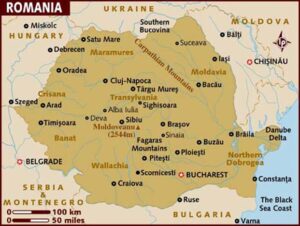Welcome to Romania | Bun venit în România
Romania is one of the larger countries of Europe (the size of the United Kingdom or roughly half of France), with a population of approx. 22 million inhabitants.
 Romania is a country located at the intersection of Central and Southeastern Europe, bordering on the Black Sea. Romania shares a border with Hungary and Serbia to the west, Ukraine and Moldova to the northeast and east, and Bulgaria to the south.
Romania is a country located at the intersection of Central and Southeastern Europe, bordering on the Black Sea. Romania shares a border with Hungary and Serbia to the west, Ukraine and Moldova to the northeast and east, and Bulgaria to the south.
Romania’s terrain is distributed roughly equally between mountainous, hilly and lowland territories. The Carpathian Mountains dominate the center of Romania, with 14 mountain ranges reaching above 2,000 m or 6,600 ft, and the highest point at Moldoveanu Peak (2,544 m or 8,346 ft). Romania’s geographical diversity has led to an accompanying diversity of flora and fauna.
Spring is pleasant with cool mornings and nights and warm days. Summers are generally very warm to hot, with summer (June to August) average maximum temperatures in Bucharest rising to 28 °C(82 °F), and temperatures over 35 °C (95 °F) fairly common in the lower-lying areas of the country. Minima in Bucharest and other lower-lying areas are around 16 °C (61 °F). Autumn is rainy and cool, with fields and trees producing colorful foliage.
Winters can be cold, with average maximum even in lower-lying areas reaching no more than 2 °C (36 °F) and below −15 °C (5 °F) in the highest mountains. Precipitation is average with over 750 mm (30 in) per year only on the highest western mountains—much of it falling as snow, which allows for an extensive skiing industry. In the south-central parts of the country (around Bucharest) the level of precipitation drops to around 600 mm (24 in), while in the Danube Delta, rainfall levels are very low, and average only around 370 mm (15 in).